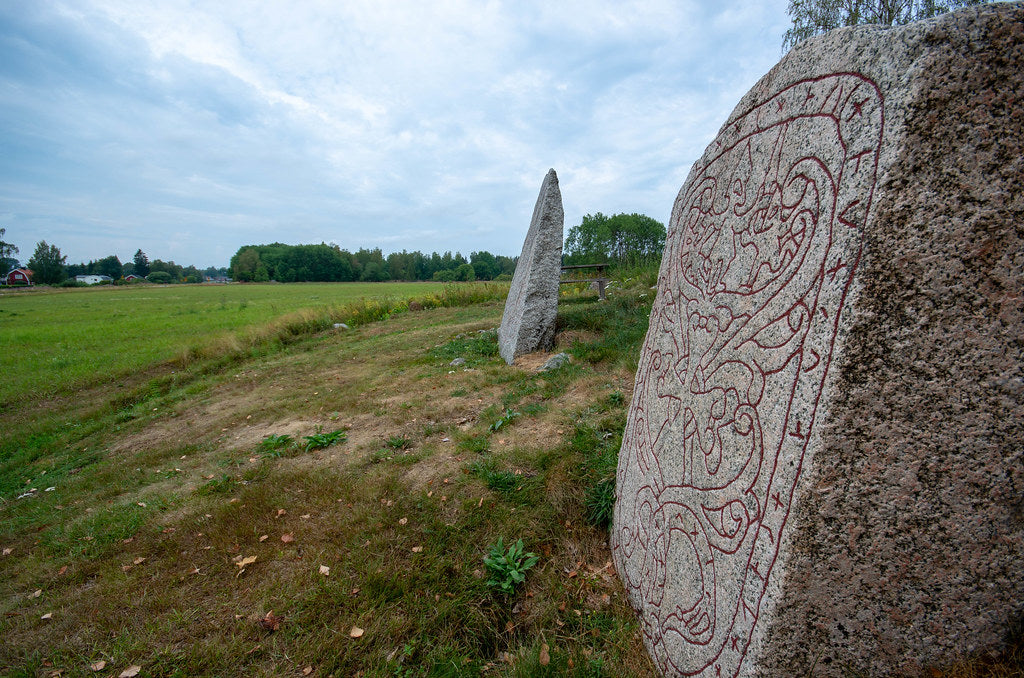Sigurd Stones: A Legend On the Stone For Decades
The Sigurd Stones were a combination of eight stones including seven runestones and one picture stone. As the name indicates, these stones tell the story of the Viking legend of Sigurd the Dragonslayer.
Sigurd was the foster son of Regin a dwarf prince. Regin fostered Sigurd for his bravery and talents and Regin was planning to use Sigurd to kill Fafnir Regin's brother. With excellent wielding skills, Sigurd managed to thrust his sword into the body of Fafnir ending his life. When the dragon slayer was cooking the heart of Fafnir, he burnt his finger that made him put his finger in his mouth. Unintentionally, he tasted the blood of the dragon from which endowed him with the ability to understand bird's songs. Then three birds came and told him that Regin his foster father was about to kill him and he must do something in advance. Before his foster father could do something to him, he beheaded Regin.
Sigurd's legend seems to become a source of inspiration for the artists back then. Sigurd stones appeared in Uppland, Södermanland, Gästrikland, Bohuslän, Gotland, and many other places.
Uppland
The two famous Sigurd stones in Uppland were the U1163 and U1175.
The U1163 depicted Sigurd thrusting his sword through a serpent/dragon who was Fafnir, the dwarf Andvari, and a Valkyrie that offered Sigurd a drinking horn. The runic inscription reads "Viðbjôrn and Karlungr and Eringeirr and Nasi had this stone raised in memory of Erinbjôrn, their father".

U1163 Viking runestone that depicted Sigurd thrusting his sword into the body of the dragon, a woman holding a drinking horn, and a man with a ring.
The U1175 bore the similarity with the U1163 and many scholars even believed that U1163 was a copy version of U1175.

The runestone U1175 was believed to be the copy version of U1163
Södermanland
The most famous Sigurd stones must be those located in Sodermanland. They include the Vasterljung runestone, Ramsund runestone, and Gök inscription.
The Vasterljung runestone located in a church and people discovered it in 1959. It was approximately 3 meters in height and carved on three sides. Although this runestone didn't depict Sigurd and his dragon-slaying scene, the runic inscription mentioned Gunnar, the brother-in-law of Sigurd.

Västerljung Sö40
Ramsund carving must be the one that vividly told the story of Sigurd the Dragonslayer. It was carved on the flat rock and the carving dated back to 1030.
The Ramsund carving although didn't tell the story with chronical order, it vividly depicted the legend of Sigurd on the rock. The explanation for the runestone is from left to right of the photo.
The Ramsund carving
- Regin was beheaded by Sigurd
- The animal could have been the otter that Otr (brother of Regin) in disguise from the beginning of the story.
- Sigurd was cooking the heart of Fafnir when he burnt his finger. The moment he licked his finger he tasted the blood of the dragon which allowed him to understand bird's song.
- The horse of Sigurd was ladden with the treasure
- The birds told Sigurd that his foster father was about to kill him.
- A man thrusting his sword into the encircling dragon must be Sigurd.
The Gok inscription is among the most controversial inscription as many scholars believe that its meaning was distorted by the Christianization process in Viking Age back then. The runestone depicted Sigurd thrust his sword into the body of Fafnir the dragon and inside the encircling dragon were the birds, the horse, a headless body, and a head.

Viking rune Gok inscription
Gästrikland
Gs 9 was the most well-preserved runestone of the Sigurd's stone back then. The man running on the top of the runestone must be Sigurd and the one that held the ring in his hand could be the Andvari the dwarf. The runic inscription on the runestone was "..., ...'s son, in memory of ... ... in memory of Þorgeirr, his brother and Guðelfr, his mother, and in memory of Ásbjorn ..."

Bohuslän
The runestone in the Bohuslan was believed to have depicted Gunnar the brother in law of Sigurd. It was the Bo NIYR;3 the baptismal font that dated back to 1100 AD.

Gotland
The Sigurd runestone in Gotland is also among the best-preserved runestones dating back to the Viking age. On the top of the runestone showed Sigurd on the horse with a dog as his company, a man holding a ring, a woman who could be the Valkyrie Brynhild, and two men fighting.






